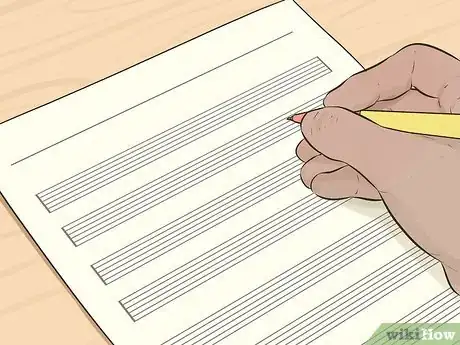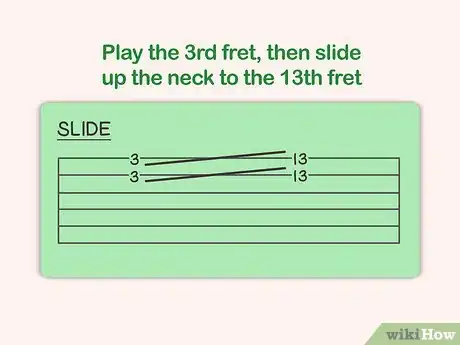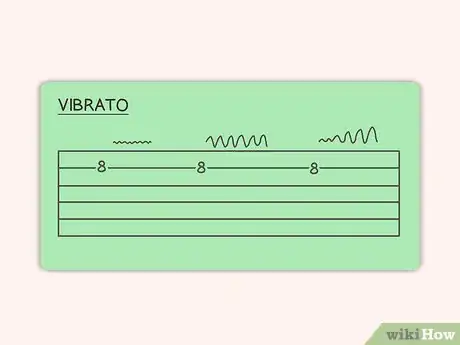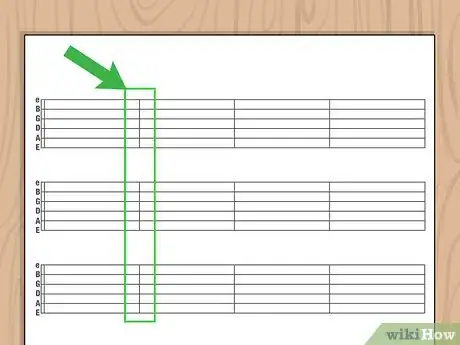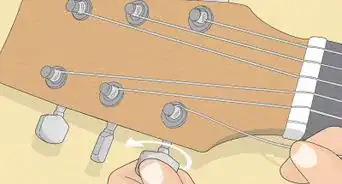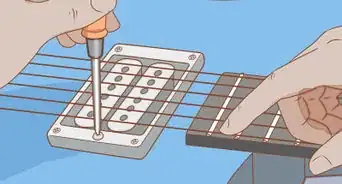This article was co-authored by Michael Papenburg and by wikiHow staff writer, Jennifer Mueller, JD. Michael Papenburg is a Professional Guitarist based in the San Francisco Bay Area with over 35 years of teaching and performing experience. He specializes in rock, alternative, slide guitar, blues, funk, country, and folk. Michael has played with Bay Area local artists including Matadore, The Jerry Hannan Band, Matt Nathanson, Brittany Shane, and Orange. Michael currently plays lead guitar for Petty Theft, a tribute to Tom Petty and the Heartbreakers.
This article has been viewed 96,164 times.
Guitar tabs are a relatively simple way to learn new songs on guitar without knowing how to read music. You don't have to know how to read music to write guitar tablature, either – all you need to know is how to play the song. Once you have the notes down, you can also add symbols to explain how to play the notes, the timing of the song, or the strum pattern to use. These symbols enable a guitarist to play the song straight from your tab, without having to hunt down the song and listen to it first.[1]
Steps
Transcribing the Notes Played
-
1Buy or print some blank tab paper. Blank tab paper is available for purchase online or at music stores. You can also download blank tab lines for free from some websites and print it yourself on your own paper. Simply search for "free blank guitar tab."[2]
- For example, there are free blank tab sheets available at https://freeblanksheetmusic.org/guitar/ and at https://www.justinguitar.com/modules/print-blank-tab-manuscript.
- A tab staff has the same number of lines as the instrument has strings. For a 6-string guitar, then, the tab staff would have 6 lines. Each of these lines corresponds to one of the strings on the guitar. If you were writing a tab for a 4-string bass, on the other hand, the tab staff would have 4 lines.
- The highest line corresponds with the highest-sounding string on the guitar, while the lowest line is the thickest and lowest-sounding string.
Tip: There are also digital apps that will help you write a tab. While these can be convenient, they don't have the same versatility that you would have if you wrote the tab yourself.
-
2Write the name of the song and the artist at the top of the tab. At a minimum, any guitarist reading your tab will need to know what song it is. Including the name of the artist is also helpful, especially if the song has been recorded by several artists.[3]
- You can also include any other information you think might be helpful, such as the name of the album where the song appears or the names of other artists who have recorded the song.
Advertisement -
3Note any alternative tuning or use of a capo. If the guitarist needs to tune their guitar differently to play the song, let them know this at the top of the tab. Likewise, if your tab requires the guitarist to use a capo, let them know which fret they should put their capo at.[4]
- Capo position is typically indicated with a Roman numeral. For example, if you want the guitarist to put their capo on the fifth fret, you would write "Capo V" at the top of the tab. If the song requires use of a capo, the notes on the tab are written relative to the capo. Essentially, the capo becomes the nut.
- Tuning may be described as relative to standard tuning. For example, if you were writing a tab for the Jimi Hendrix song "Crash Landing," you might say "tune guitar down a 1/2 step."
Tip: If you add chord names to your tab and you're using a capo, write the name of the chord as it would be without the capo. Guitarists will recognize the shape of the chord more easily that way.
-
4Write numbers on the lines that correspond to where the string is fretted. To start transcribing the notes of the song, play the song. Start slow and play 1 or 2 notes, then pause and write them down. To transcribe a chord, write the fret numbers for each string stacked on top of each other in a vertical.[5]
- You can also transcribe a song by watching someone else play the song and writing down the fret numbers that correspond to the notes they're playing. If you know the chords and the chord shapes, you may not even need to play the song at all to write the tab.
- While writing your tab, pause periodically and play directly from the tab to check your work.
-
5Use an "x" for strings that should be muted or played percussively. If notes are meant to be muted, write an "x" on the line that corresponds to each note. If an entire chord is written out with an "x" on each of the strings, this indicates that the chord is meant to be played percussively with the strings muted. This is more common on an electric guitar tab, but may also be seen on an acoustic guitar tab.[6]
- When transcribing a chord to tab, including no number on a line indicates that string is to be played open. If it isn't played or is muted, you would also use an "x" on the line that corresponds to that string.
Communicating How to Play the Notes
-
1Add information about the style of the song to the top of the tab. Any comments you can give at the top of the tab will give the guitarist a better understanding of how the song should be played. Include the genre of the song so the guitarist has a feel for the general mood of the song, then describe in basic terms how to play the notes.[7]
- For example, if you were writing a tab for the Rolling Stones' cover of "Love in Vain," you might include a note to "play as a blues-country, more formalized than straight blues. Let notes ring out and bleed to create a haunting, desolate sound."
- In the tab itself, it can be helpful to label the parts of the song. Most songs have verses and a chorus, and many also have a bridge. Each of these parts may have different moods.
Tip: If you're writing a tab for an electric instrument, you might also include information about any effects pedals that are used.
-
2Draw straight lines between notes to indicate a slide. Straight lines connecting two notes on a tab horizontally tell the guitarist to slide from the first note to the next. Include as many lines as notes. When a guitarist sees this symbol in a tab, they know to slide their fingers up the neck of the guitar from one note to the next without stopping.[8]
- For example, if you had the number 4 on two lines of the tab followed by 2 horizontal lines connecting to a 14 on the same two lines, the guitarist would know to slide from the fourth fret to the 14th fret on those 2 strings.
-
3Use curved lines between notes to indicate hammer-ons and pull-offs. Draw an arc from one note to the next if the notes are meant to be played as hammer-ons or pull-offs while the note continues to ring. Connecting a lower fret to a higher fret indicates a hammer-on. If you connect a higher fret to a lower fret, that tells the guitarist to do a pull-off.[9]
- Some transcribers also use a "p" or an "h" to indicate hammer-ons and pull-offs. For example, a "5p4" on a tab would indicate that the guitarist frets that string at the fifth fret, then pulls off to the fourth fret.[10]
-
4Write a squiggly line to indicate vibrato. A squiggly line either above or below the tab after a note indicates that note should be played with vibrato. You can vary the height and rate of your squiggle to indicate the speed of the vibrato.[11]
- A smaller squiggle that gets larger, for example, could be used to indicate a gradually increasing vibrato.
Adding Timing and Strum Patterns
-
1Put a time signature at the top of the page or beginning of each line. A standard time signature, such as 4/4 or 3/4, tells the guitarist how many beats the song has per bar or measure. Understanding the rhythm of the song will help the guitarist play the song more smoothly.[12]
- A time signature also gives the guitarist an idea about strum patterns, since each time signature has common strum patterns that are used.
-
2Follow the same spacing as the sheet music. Even if you don't read music, you can use the sheet music for a song to space the notes on your tab. This gives guitarists reading your tab a better understanding of the timing and rhythm of the song.[13]
- You can also use vertical lines to mark off measures. This is especially helpful if you've included a time signature.
-
3Include lyrics so the guitarist can follow the tab more easily. If you write out the lyrics below the tab staff, the guitarist can figure out the timing better and will be able to follow the song as they play. The timing of the lyrics also gives the guitarist clues about the timing they should play.[14]
- For example, if a particular word is drawn out, this tells the guitarist that they should also hold out the note they're playing.
Tip: Listening to the original artist performing the song can help you place the lyrics in the right places in your tab.
-
4Provide information about the strum pattern on your tab. A downstroke is indicated by a symbol that looks like an open-bottomed box. An upstroke is indicated by a V-shaped symbol. Placing these symbols above the notes in your tab tells the guitarist reading your tab exactly how to strum the notes.[15]
- This notation is especially helpful if you're writing a tab for beginning guitarists. However, even if you're writing a more advanced tab, strum pattern notation can still be useful if the song has a particularly complex strum pattern.
EXPERT TIPMichael Papenburg is a Professional Guitarist based in the San Francisco Bay Area with over 35 years of teaching and performing experience. He specializes in rock, alternative, slide guitar, blues, funk, country, and folk. Michael has played with Bay Area local artists including Matadore, The Jerry Hannan Band, Matt Nathanson, Brittany Shane, and Orange. Michael currently plays lead guitar for Petty Theft, a tribute to Tom Petty and the Heartbreakers.Professional Guitarist
 Michael Papenburg
Michael Papenburg
Professional GuitaristOur Expert Agrees: The biggest problem with guitar tabs is that they often don't include any rhythmic information. They'll have standard notation at the top, and then the tab at the bottom, but that's just the number of the fret and the string that you're playing. However, you can include rhythmic notes, such as whole notes, half notes, and quarter notes, along with each number. Then, you don't have to remember what the rhythm is, because you're seeing it at the same time that you're reading the tab.
Community Q&A
-
QuestionHow do I actually write a tab?
 Community AnswerWhen I tab, I play by ear, then write it down. If you have sheet music, remember every fret goes up one-half step. Think of a piano. There is no black key between B and C. Same for E and F. In those instances, it is only necessary to go up one fret instead of two to go up a note.
Community AnswerWhen I tab, I play by ear, then write it down. If you have sheet music, remember every fret goes up one-half step. Think of a piano. There is no black key between B and C. Same for E and F. In those instances, it is only necessary to go up one fret instead of two to go up a note. -
QuestionHow do I know which fret to play the note on?
 Community AnswerIt depends whether you are reading from sheet music or tabs. When you are reading from tabs, just play the fret which number matches the number on the tab. When you are reading from sheet music, just try to find the position that's most comfortable to reach all the notes.
Community AnswerIt depends whether you are reading from sheet music or tabs. When you are reading from tabs, just play the fret which number matches the number on the tab. When you are reading from sheet music, just try to find the position that's most comfortable to reach all the notes. -
QuestionHow do I add guitar chord pictures to tablature?
 Community AnswerIt depends on what website/editor/program you are using. Some use a simple 'import file' while others require a whole mound of HTML.
Community AnswerIt depends on what website/editor/program you are using. Some use a simple 'import file' while others require a whole mound of HTML.
References
- ↑ https://www.musicnotes.com/now/tips/how-to-read-guitar-tabs/
- ↑ https://www.musicnotes.com/now/tips/how-to-read-guitar-tabs/
- ↑ http://www.classtab.org/tabbing.htm
- ↑ http://www.classtab.org/tabbing.htm
- ↑ https://www.musicnotes.com/now/tips/how-to-read-guitar-tabs/
- ↑ https://www.justinguitar.com/guitar-lessons/writing-down-melody-in-tab-tr-102
- ↑ http://www.classtab.org/tabbing.htm
- ↑ https://www.musicnotes.com/now/tips/how-to-read-guitar-tabs/
- ↑ https://www.musicnotes.com/now/tips/how-to-read-guitar-tabs/
- ↑ http://www.classtab.org/tabbing.htm
- ↑ https://www.justinguitar.com/guitar-lessons/writing-down-melody-in-tab-tr-102
- ↑ https://www.guitarworld.com/acoustic-nation/acoustic-guitar-strumming-patterns
- ↑ https://www.musicnotes.com/now/tips/how-to-read-guitar-tabs/
- ↑ http://www.classtab.org/tabbing.htm
- ↑ https://www.guitarworld.com/acoustic-nation/acoustic-guitar-strumming-patterns
